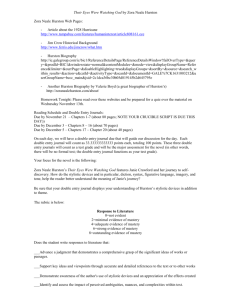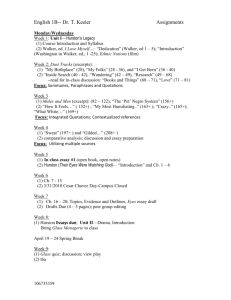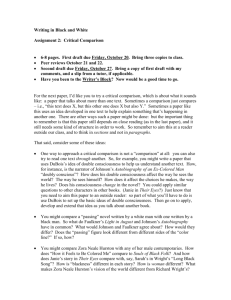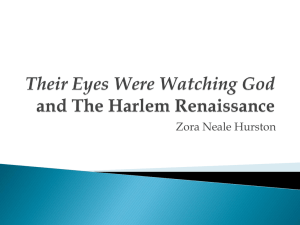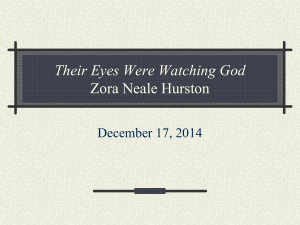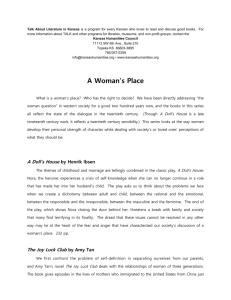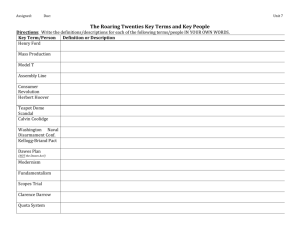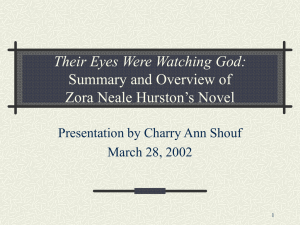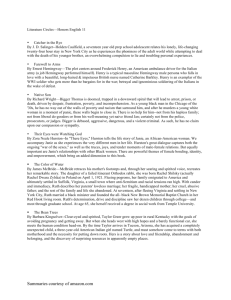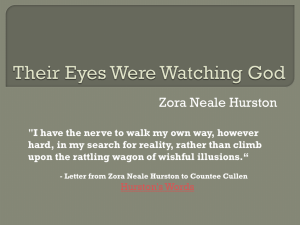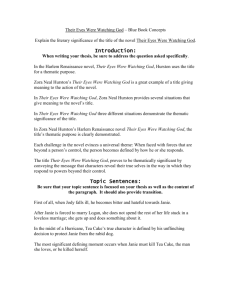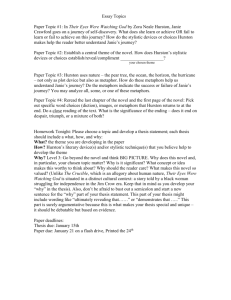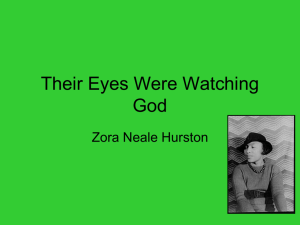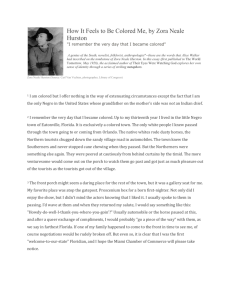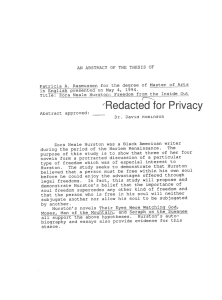The Essay
advertisement
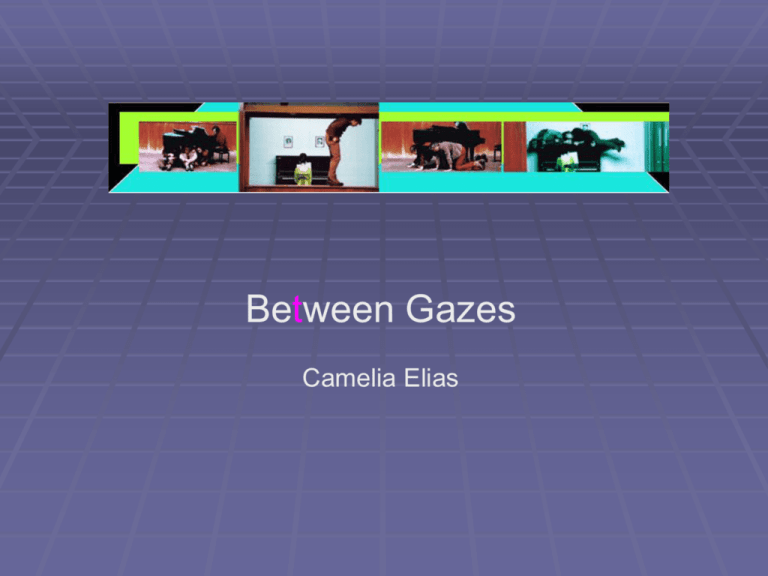
Between Gazes Camelia Elias Homi Bhabha (1949) A leading voice in postcolonial studies. Highly influenced by Western poststructuralist theorists, notably Jacques Derrida, Jacques Lacan and Michel Foucault. In Nation and Narration (1990), he argues against the tendency to essentialize Third World countries into a homogenous identity. Instead, he claims that all sense of nationhood is narrativized. He has made a major contribution to postcolonial studies by pointing out how there is always ambivalence at the site of colonial dominance. In his Location of Culture (1994), he uses concepts such as mimicry, interstice, hybridity, and liminality to argue that cultural production is always most productive where it is most ambivalent. The ambivalence of colonial discourse Drawing on a Foucauldian concept of power (decentred, multiple, all permeating) he points out the problematic position of the people exerting colonial rule. By placing the colonizers within the domain of colonial discourse too, he breaks down the simple binary colonizer/colonized and opens a space for a theorization of ambivalences, contradictions and hidden feelings. The complex construction of difference and sameness in the colonial relationship centrally involves identification as well as the crisis of identification, a complex, ambivalent and often contradictory mode of representation. “mimicry” metaphor for a process of acculturation and adaptation of imposed cultural concepts and patterns by the colonized; a strategic adaptation by the colonized as a subtle act of resistance. In its contradictions it unfolds the whole ambivalence of the colonial discourse. “The discourse of mimicry is constructed around an ambivalence; in order to be effective, mimicry must continually produce its slippage, its excess, its difference Mimicry is, thus, the sign of a double articulation; a complex strategy of reform, regulation, and discipline, which 'appropriates' the Other as it visualizes power. Mimicry is also the sign of the inappropriate, however, a difference or recalcitrance which coheres the dominant strategic function of colonial power, intensifies surveillance and poses an immanent threat to both 'normalized' knowledges and disciplinary powers.“ (122-123). Zora Neale Hurston (1891/1901?-1960) Born in Alabama Moved to Eatonville, Florida at age 3 5th of 8 children Mother died when she was 11 she did not get along with step-mother…left home at 17 to travel with a theatre company beginning career Finished high school at Morgan Academy in Baltimore when she was in her twenties Attended Howard University on and off for four years, working as a manicurist to support herself 1921: Her first published story appears in Howard University’s literary magazine 1925: Another story published in New York Magazine…wins second place for the story. Is encouraged by other writers to move to New York City… NYC Harlem Renaissance: attended parties with writers like Langston Hughes Very popular: known for her hat perched jauntily on her head and for shocking people with her rebellious behavior, like smoking in public! received a B.A. in anthropology from Barnard College, NYC in 1928 was the school’s first black student! influences Zora’s Hometown - Eatonville, Florida First incorporated all-black community in America Father was elected mayor several times Eatonville’s folklore and people significantly influenced her writing. Back to her roots… 1927: awarded a fellowship from Columbia University With “spyglass of anthropology” she set off in her car, “Sassie Susy” on an adventure of research and rediscovery African-American Folklore…inspired by experiences in Eatonville This adventure took her two decades and she traveled all across Florida, to the islands of the Caribbean, and the coast of Central America. Later years spent her later years in Florida, unable to make a living from her writings, and worked as a teacher, librarian, and domestic in order to survive. Continued writing three additional novels which were rejected for publication After suffering a stroke in 1959, she was forced to enter the St. Lucie County Welfare Home. Died nearly a year later of hypertensive heart disease Buried in an unmarked grave in Fort Pierce, Florida. Their Eyes Were Watching God Considered to be Hurston’s most powerful novel At the time of publication, it received mixed reviews. Criticized for not being in the protest tradition, not being bitter enough, etc. Story of Janie Crawford, a Southern black woman in the 1930s whose journey from a free-spirited girl to a woman of independence and substance has inspired writers and readers for close to 70 years. For nearly thirty years, it was out of print, until… critics rediscover Hurston Henry Louis Gates, Jr., a renowned African American historian, has been one among many to ask: "How could the recipient of two Guggenheims and the author of four novels, a dozen short stories, two musicals, two books on black mythology, dozens of essays, and a prize winning autobiography virtually 'disappear' from her readership for three full decades?" Alice Walker Although it was out of print and difficult to find, in the ’60s and ‘70s, the novel went through an underground phenomenon. Many African-American studies courses were teaching the book. Alice Walker (The Color Purple) was teaching the book and discovered Hurston was buried in an unmarked grave with little to no recognition for her literary achievements. In Search of Zora Neale Hurston… Zora Neale Hurston “A Genius of the South” 1901-1960 Novelist, Folklorist, Anthropologist 1973: Walker began her search for Hurston’s grave to put a marker on 1975: Walker publishes personal essay about this experience this launches a Hurston revival and a mass reprinting of the novel. “We are a people. A people do not throw their geniuses away. If they do, it is our duty as witnesses for the future to collect them again for the sake of our children. If necessary, bone by bone.” Alice Walker, 1976. stamp dedication February 28, 2003 “I feel that I have lived. I have had the joy and pain of strong relationships. I have made enemies of which I am not ashamed. I have been faithless, and then I have been faithful...I have loved unselfishly...and have hated with all the power of my soul...I have touched the four corners of the horizon, for from hard searching it seems to me that tears and laughter, love and hate, make up the sum of life.“ Dust Tracks on a Road (1942) against stereotyping Argue all you will or may about injustice, but as long as the majority cannot conceive of a Negro or a Jew feeling and reacting inside just as they do, the majority will keep right on believing that people who do not look like them cannot possibly feel as they do, and confirm to the established pattern. It is well known that there must be a body of waived matter let us say, things accepted and taken for granted by all in a community before there can be that commonality of feeling. The usual phrase is having things in common. Until this is thoroughly established in respect to Negroes in America, as well as other minorities, it will remain impossible for the majority to conceive of a Negro experiencing a deep and abiding love and not just the passion of sex. "What White Publishers Won't Print," 1950 Their Eyes Were Watching God watching: passing and active caring and controlling appropriated and appropriating divine and evil community reconsidered how does the different clothing signify Janie's stages in her quest for self and identity? how does each house represent/reflect a different stage in Janie's search/quest for her identity? how do the images of fertility correspond with Janie's inward growth and desire? how does each person's perception of marriage affect and compare to Janie's perception of love, marriage, and self? how does each man shape, change, encourage, or stifle Janie as she searches for her voice/self? consider Jeanie’s self assertion in relation to her dependency on men. mules and masks "Honey, de white man is de ruler of everything as fur as Ah been able tuh find out. Maybe it's some place way off in de ocean where de black man is in power, but we don't know nothin' but what we see. So de white man throw down de load and tell de nigger man tuh pick it up. He pick it up because he have to, but he don't tote it. He hand it to his womenfolks. De nigger woman is de mule of de world so fur as Ah can see." (Zora Neale Hurston, Their Eyes Were Watching God, the novel) Negro writer vs. universal writer "Negroes are supposed to write about the Race Problem. I was and am thoroughly sick of the subject. My interest lies in what makes a man or a woman do such-and-so, regardless of his color." Dust Tracks on a Road
